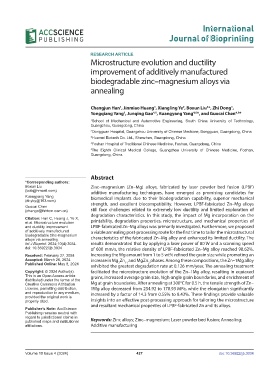Page 435 - IJB-10-4
P. 435
International
Journal of Bioprinting
RESEARCH ARTICLE
Microstructure evolution and ductility
improvement of additively manufactured
biodegradable zinc–magnesium alloys via
annealing
Changjun Han , Jinmiao Huang , Xiangling Ye , Boxun Liu *, Zhi Dong ,
3
1
2
1
1
Yongqiang Yang , Junqing Gao , Kuangyang Yang *, and Guocai Chen *
4,5
1
4,5
4,5
1 School of Mechanical and Automotive Engineering, South China University of Technology,
Guangzhou, Guangdong, China
2 Dongguan Hospital, Guangzhou University of Chinese Medicine, Dongguan, Guangdong, China
3 Huamei Biotech Co. Ltd., Shenzhen, Guangdong, China
4 Foshan Hospital of Traditional Chinese Medicine, Foshan, Guangdong, China
5 The Eighth Clinical Medical College, Guangzhou University of Chinese Medicine, Foshan,
Guangdong, China
Abstract
*Corresponding authors:
Boxun Liu Zinc–magnesium (Zn–Mg) alloys, fabricated by laser powder bed fusion (LPBF)
(bob@hmcell.com) additive manufacturing techniques, have emerged as promising candidates for
Kuangyang Yang biomedical implants due to their biodegradation capability, superior mechanical
(dr.yky@163.com)
Guocai Chen strength, and excellent biocompatibility. However, LPBF-fabricated Zn–Mg alloys
(chengc@fshtcm.com.cn) still face challenges related to extremely low ductility and limited exploration of
degradation characteristics. In this study, the impact of Mg incorporation on the
Citation: Han C, Huang J, Ye X,
et al. Microstructure evolution printability, degradation properties, microstructure, and mechanical properties of
and ductility improvement LPBF-fabricated Zn–Mg alloys was primarily investigated. Furthermore, we proposed
of additively manufactured a viable annealing post-processing route for the first time to tailor the microstructural
biodegradable zinc-magnesium
alloys via annealing. characteristics of the fabricated Zn–Mg alloy and enhanced its limited ductility. The
Int J Bioprint. 2024;10(4):3034. results demonstrated that by applying a laser power of 80 W and a scanning speed
doi: 10.36922/ijb.3034 of 600 mm/s, the relative density of LPBF-fabricated Zn–Mg alloy reached 98.62%.
Received: February 27, 2024 Increasing the Mg amount from 1 to 5 wt% refined the grain size while promoting an
Accepted: March 26, 2024 increase in Mg Zn and MgZn phases. Among these compositions, the Zn–1Mg alloy
2
11
2
Published Online: May 8, 2024 exhibited the greatest degradation rate at 0.126 mm/year. The annealing treatment
Copyright: © 2024 Author(s). facilitated the microstructure evolution of the Zn–1Mg alloy, resulting in equiaxed
This is an Open Access article grains, increased average grain size, high-angle grain boundaries, and enrichment of
distributed under the terms of the
Creative Commons Attribution Mg at grain boundaries. After annealing at 300°C for 0.5 h, the tensile strength of Zn–
License, permitting distribution, 1Mg alloy decreased from 254.92 to 170.93 MPa, while the elongation significantly
and reproduction in any medium, increased by a factor of 14.3 from 0.55% to 8.43%. These findings provide valuable
provided the original work is
properly cited. insights into an effective post-processing approach for tailoring the microstructure
and resultant mechanical properties of LPBF-fabricated Zn and its alloys.
Publisher’s Note: AccScience
Publishing remains neutral with
regard to jurisdictional claims in
published maps and institutional Keywords: Zinc alloys; Zinc–magnesium; Laser powder bed fusion; Annealing;
affiliations. Additive manufacturing
Volume 10 Issue 4 (2024) 427 doi: 10.36922/ijb.3034

